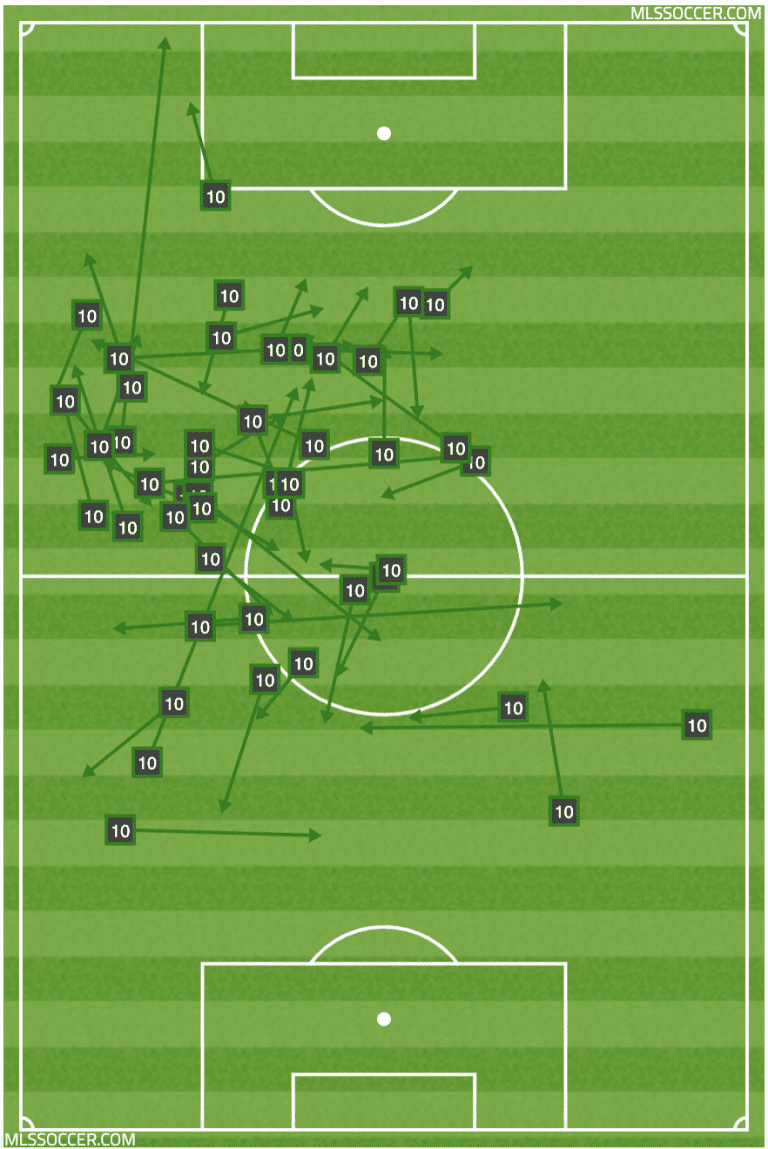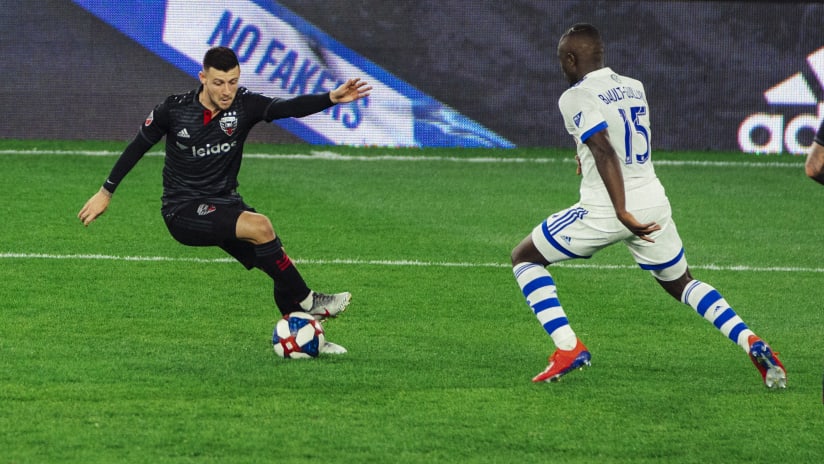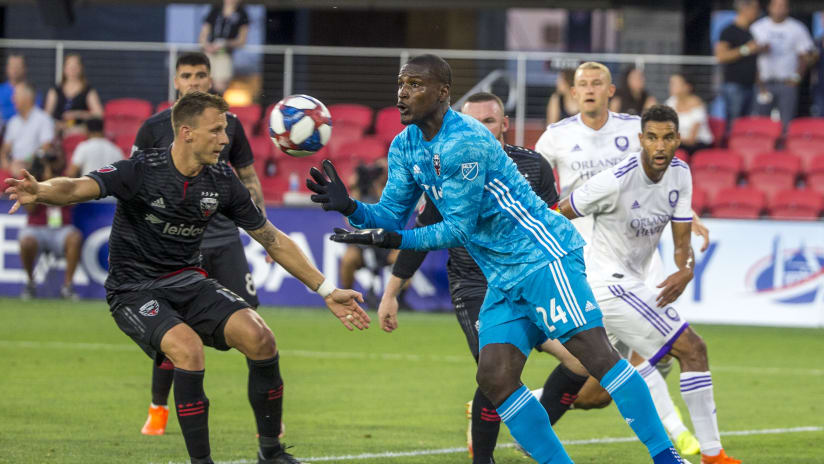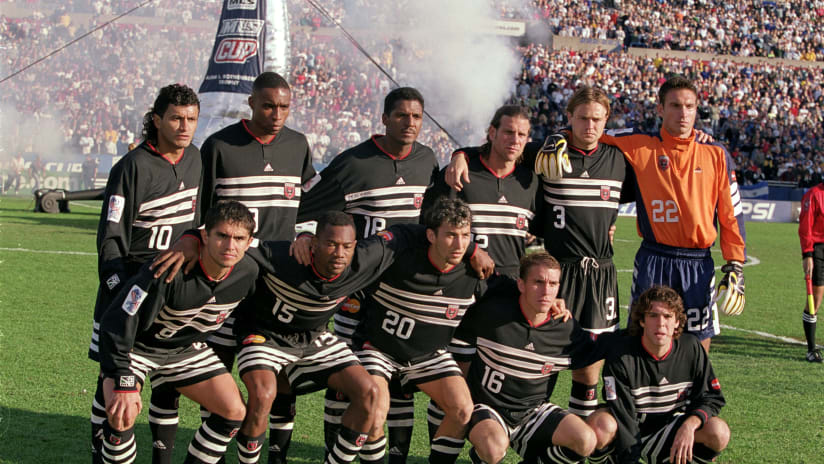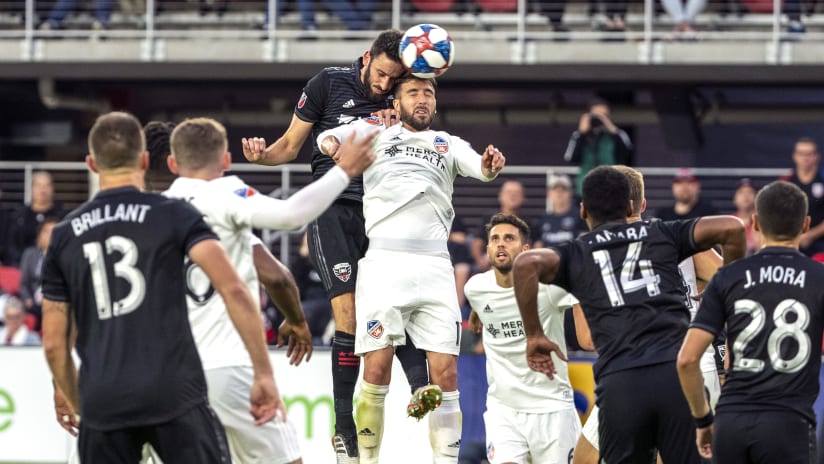A brutal week on the Major League Soccer schedule saw D.C. United fly roundtrip to the Pacific Northwest before hosting its biggest rival during a midweek game and then, two days later, bussing north for its third match in seven days. Weary, worn-out and without its captain for nearly two full games, United suffered three consecutive defeats in the thick of the Eastern Conference playoff race.
In an attempt to turn the tide, the Black-and-Red held a team meeting Tuesday morning in which players and coaches were encouraged to share their thoughts about what needs to be changed down the stretch.
“That’s between me and the team,” coach Ben Olsen said earlier this week. “You know how these moments in the season are. It’s emotional and it’s good to sometimes get some things off your chest and let the players speak and let the head coach speak. Just throw it on the table, man.
“I think we’ve identified some things that well need to do better. That doesn’t mean snap your fingers and now become a great team after a little bit of a slump. But there’s little ways to chip away and get back to the form that we believe we can get to. There’s talent in there. But that’s not going to be enough. We have to bring more in a whole host of areas.”
Here’s what you need to know before kickoff:
Opponent: Montreal Impact
Record: 11 wins, 14 losses, 4 draws
Standings: 7th place in the Eastern Conference, level on points with Toronto FC but leading in total wins, which is the league’s first tiebreaker
Last match: Win, 2-1, vs. Vancouver Whitecaps FC
Head coach: Wilmer Cabrera; first season; overall record of 1 win, 1 loss, 0 draws
Montreal shocked the MLS community by sacking manager Remi Garde on August 21, just a few days after the team wasted a 3-0 lead against FC Dallas and settled for a deflating draw. Garde’s replacement, Wilmer Cabrera, served as head coach of the Houston Dynamo beginning with the 2017 season and led them to the U.S. Open Cup title the following year. Cabrera also served as head coach of Chivas USA, in 2014, and worked previously as an assistant for the Colorado Rapids, in 2012 and 2013. He gained additional coaching experience with various age groups in the U.S. Men’s Youth National Program, most notably the U17 group from 2007-12.
Olsen was asked about coaching turnover in MLS earlier this week.
“I think as pressure mounts and more money is spent and more eyes are on this league, I think that’s probably a trend that will increase just like it does in the rest of the world,” Olsen said. “It also seems like there’s cycles in this. There’s years where five, six, seven (head coaches) go. And there’s years where everybody kind of hangs in there and there’s one or two. I wouldn’t want to pigeonhole this year. It does seem like there’s a lot of different new coaches and new ideas.”
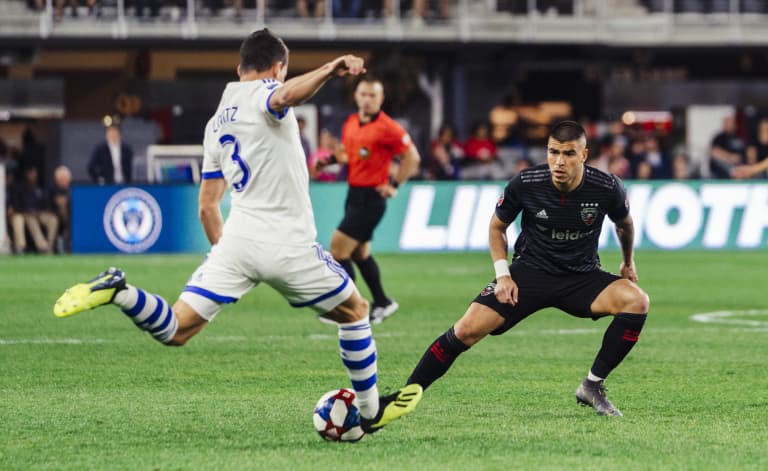
Tactical analysis: Cabrera’s coaching influence
With Garde at the helm, the Impact attacked heavily from the right side of their formation in the overwhelming majority of matches. Their attack numbers for the season hover at 42 percent down the right flank, 21 percent through the middle and 36 percent down the left flank, according to data compiled by WhoScored. And in certain games, such as Garde’s last victory on July 19, the numbers were skewed even more drastically toward one side of the pitch: 46 percent down the right flank, 20 percent through the middle, 34 percent down the left flank.
That trend seems to have flipped since Cabrera took over, albeit in a very small sample size of two games. In Cabrera’s first match, against Toronto, the Impact switched its emphasis from the right flank to the left. They finished with 43 percent of their attack down the left, 20 percent through the middle and 37 percent down the right. And that trend held fairly steady in Cabrera’s second game, against Vancouver, when the Impact attacked 38 percent down the left, 25 percent through the middle and 37 percent down the right side.
While these numbers may seem insignificant given the recency of the coaching change, consider this: There were only four matches all season in which the Impact attacked more often down the left flank than the right under Garde. It’s now happened twice in two matches under Cabrera.
Player to watch: Bojan Krkic, forward
Krkic signed with the Impact as a free agent in early August prior to the MLS transfer window closing and arrived with a fairly impressive reputation — albeit one that has dimmed slightly in recent years. Krkic worked his way through the Barcelona youth teams and eventually made his first-team debut in 2007. He spent the next four seasons with the La Liga giants and earned 23 or more league appearances each year. His best season, the 2007-08 campaign, featured 10 goals in 31 league appearances and 12 goals in 48 total appearances across all competitions. He averaged 10.25 goals per year for Barcelona from 2007-11.
In many ways, though, those four seasons represented the pinnacle of Krkic’s career. He went on to play for A.S. Roma and A.C. Milan in Serie A, AFC Ajax in the Eredivisie and Stoke City in the English Premier League before mutually parting ways with the English club following a pair of unremarkable loan appearances in Germany and Spain. His best season since leaving Barcelona was the 2015-16 campaign with Stoke in which Krkic scored seven goals in 27 games in the Premier League.
Krkic, who turned 29 earlier this week, made his MLS debut as a substitute on August 10 and quickly entered the starting lineup for the next three matches. He scored his first goal on a 25-yard strike during a 2-1 loss to Toronto on Aug. 24.
Stat to know: The Impact have the worst goal differential (-11) of any team in a playoff position
Generally speaking, teams with positive goal differentials can be expected to sit higher in the standings than teams with negative goal differentials. Any team that scores more goals than it allows over the course of a season has, in at least one respect, done something right.
Which is why it’s unusual to glance at this year’s playoff picture and notice the Impact clinging to life despite a -11 goal differential, tied for the third-worst mark in the entire league. Only FC Cincinnati (-37) and Vancouver (-21) have had leakier defenses over the course of the season.
So how did it happen? A look through the Impact’s fixtures show a number of heinous, multi-goal defeats that offset an otherwise decent campaign: a 7-1 loss to Sporting Kansas City; a 3-0 loss to the Union; a 3-0 loss to Orlando City and a 6-3 loss to the Colorado Rapids. Those four games alone generated a -15 goal differential that would be difficult for most teams to overcome.
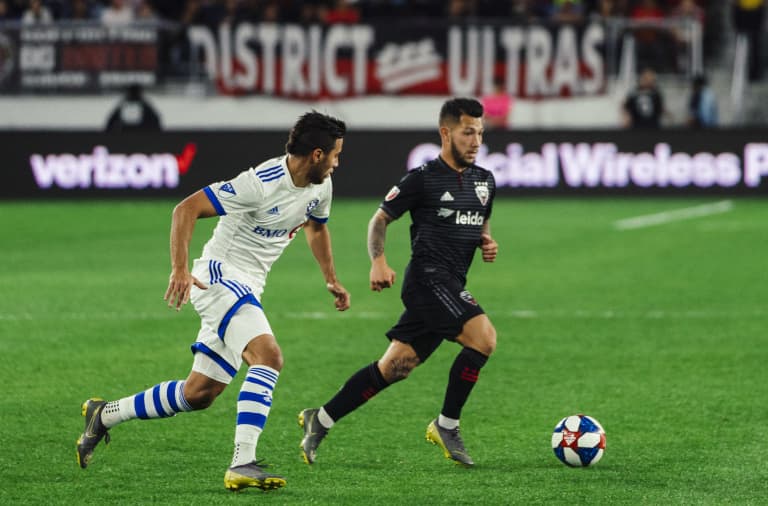
At the moment, though, Montreal lays claim to the final playoff spot with five games remaining and would be something of a trendsetter if they end up qualifying for the postseason. No team has reached the Eastern Conference playoffs with a goal differential of -11 or worse since the Miami Fusion posted a -17 goal differential in 1999 and earned the No. 4 seed in the east.
“This is a huge game,” Olsen said. “Not only because we’re looking to snap out of this skid, but also where they’re at in the table and it’s a team that’s moving up and looking to get into a playoff spot. Any time you can keep those guys down, it’s beneficial, especially in the spot we’re at.
“We have a five-game season at this point, and there has to be real accountability and quality to get a few wins and get into the playoffs. And I’ve been in this league a long time and I’ve seen so many different pathways to winning or making a great run in the playoffs.
“Everybody goes through these stretches. How many teams in the league have lost three in a row? There’s a lot of them. Our stretch now, it’s not a good one, and we’ve just got to keep trying to battle out of it. It starts with hard work. It starts with accountability. It starts with fixing these tough starts that we’ve had and getting ourselves behind the 8-ball. It starts with sometimes using the emotion but also putting it aside and understanding that this week could have gone differently very quickly.”
Key to victory: Getting the best out of Lucho Acosta
One of the bright spots for United during Saturday’s loss to the Union was the inspired play of Acosta, who returned to the starting lineup and scored the team’s only goal. Acosta operated mostly off the left-hand side and seemed eager to run at defenders while linking with his teammates for give-and-go passes that torment opposing back lines. Acosta had 96 touches against the Union — 16 more than any of his United teammates — and remained disciplined with his positioning throughout the match.
As Acosta’s heatmap and passing map show, he imposed himself on a distinct area of the field rather than floating from sideline to sideline as he’s done in the past. And while there is certainly a time and a place for Acosta to roam — such is often the responsibility of the playmaking midfielder — the coaches had to be thrilled with his commitment to shape both with the ball and without. The best way to break down an opposing team or pressure the opposition in defense is to have all 11 players maintaining positional integrity, which Acosta did beautifully against the Union last weekend.
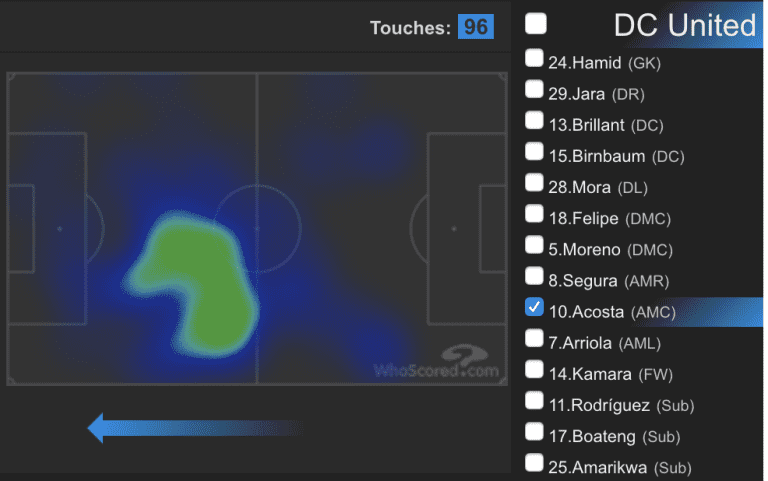
All signs point toward Acosta having a chance to replicate that performance Saturday against the Impact, especially with striker Wayne Rooney serving the second game of his suspension. Acosta trained with purpose throughout the week and appears keen on showing Olsen why he should be included in the starting lineup down the stretch. Perhaps an invigorated Acosta is exactly what United needs with five games remaining.
